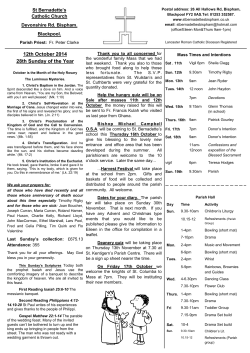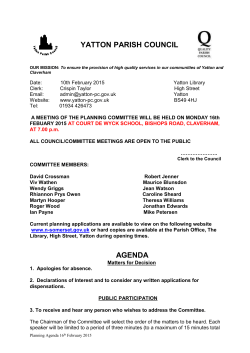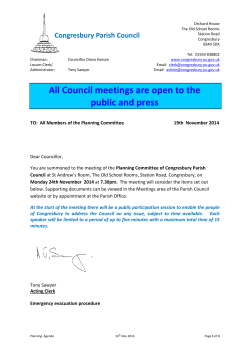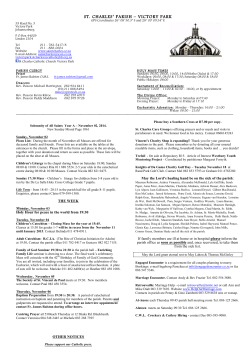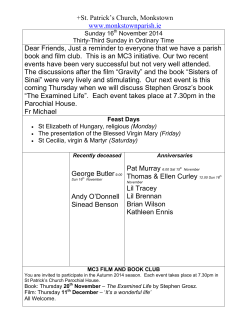
PARISH PLANNING AND VIABILITY STUDY
ARCHDIOCESE OF ST. LOUIS PARISH PLANNING AND VIABILITY STUDY 2 PARISH PLANNING PROCESS OVERVIEW This process is designed to help the leadership and parishioners of every parish as well as the leadership of the Archdiocese of St. Louis to: 1) strengthen parishes through a viability assessment, and 2) determine contingency plans for future parochial administrative structures and staffing. The five distinct steps in this planning process will be outlined below. Before initiating this process on the parochial level, the deans and Priest Council deliberated, input was collected from and shared among the clergy of every deanery, and all priests of the Archdiocese were familiarized with the purpose, procedures, and expected outcomes of the process. The instrument used in this process has been tailored to suit the situation and needs of the Archdiocese of St. Louis. Each parish must follow the same uniform process for it to be effective, consistent, and measurable. FORMING A PARISH PLANNING TEAM The pastor should identify and form his “parish planning team” for the purpose of initiating and then helping facilitate the process in the parish. This group can be formed from among the Pastoral Council or equivalent group, Parish Finance Council, clergy, parish staff, and other key leaders. The pastor may also choose to appoint a “parish planning team coordinator” to help form this group and to oversee the whole parish planning process. Once this parish planning team has undertaken the planning process as a group (known as the first implementation), the process should be extended to a larger representative group of the parish and ideally to all interested parishioners (known as the second implementation). The parish planning team is invited to a training session provided by the Archdiocese. This orientation will familiarize the parish planning team with: 1) the principles, background, and importance of the process; 2) how to facilitate the process in the parish; 3) resources, tools, and strategies to successfully undertake the process; and 4) timeline for completion. PROCEDURAL MODELS FOR THE SECOND IMPLEMENTATION After the parish planning team completes the process first (first implementation), the group then becomes responsible for engaging the process a second time (known as the second implementation). This second implementation may be conducted according to either of the following two procedural models: 1) The pastor or parish planning team convenes a group of all interested parishioners (known as the “parish assembly”) from among the entire parish membership to complete the second implementation of the process; 2) The pastor or parish planning team identifies at least one representative from each parish organization, group, and demographic (known as the “parish 3 representation”) to comprise the participants in a gathering that will complete the second implementation of the process. If the parish employs the second procedural model, great care must be taken to assemble a “parish representation” for the second implementation that genuinely represents a cross-section of the parish and can speak credibly for all parishioners. One meeting may be sufficient for the parish planning team to adequately complete the process in the first implementation. However, for the larger group of the second implementation where the entire parish membership may be involved in the process, two meetings may be needed to adequately complete the process. GUIDELINES FOR THE SECOND IMPLEMENTATION Regardless of which procedural model is chosen for the second implementation, at the time when the larger group of the parish is convened (be it the “parish assembly” or the “parish representation”), the parish is asked to observe the following guidelines for the second implementation: • The first gathering should be a general meeting used to introduce the process, explain how to use the instrument, and answer questions related to using the instrument properly. The pastor may position the parish planning team or a “parish planning team coordinator” (having already undergone the process in the first implementation) to help guide this meeting. • At the conclusion of the first general meeting of the second implementation, those participating in the process may be invited to independently rate the statements presented in the instrument of Parish Viability Profile while following the instructions. In this situation, each family or household is requested to use only one instrument each. While individuals may fill out the instrument, the process works best if at least two people together complete each instrument, thus allowing for discussion and consensus. Whenever they disagree regarding the rating to be given to an individual statement, those rating the statements need to discuss their responses and arrive at a consensus so that only one rating score is given to each statement. • In the second implementation scenario, the parish planning team, who has already arrived at consensus and completed the process in the first implementation, is considered the control group. This control group, having been composed of individuals who have a thorough knowledge of the full operation of the parish, helps to facilitate the second implementation and to supply relevant information on the parish to the larger group to enable them to give input and respond to the assessment. • At a second gathering of the “parish assembly” or “parish representation” during the second implementation, the overall Parish Viability Rating (Step Two) as determined by the control group is presented. Those attending then have the opportunity to compare their overall responses (which they will have completed 4 independently at home with their families or friends) to the response of the control group, discuss individual concerns and impressions about the parish generated through use of the instrument, and come to a general consensus regarding the viability of the parish. • The pastor and the parish planning team should also be prepared to convey the conclusions drawn and insights gained from Steps Three, Four, and Five to the “parish assembly” or the “parish representation” during this gathering of the second implementation. Their responses should be shared and explained. Finally, through discussion and feedback guided by the responses of the control group, this process should eventually result in a refining and/or validation of the control group’s responses. STEP ONE: UNDERSTANDING THE CHALLENGE The pastor of each parish should share information with his parish planning team and parishioners regarding the current status of the Archdiocese and its parishes with relation to (1) the pending shortage of available clergy to serve as pastors, (2) parish population and the ratio of priest to Catholics in the deaneries, and (3) basic facts about their own parish: number in attendance at weekend Masses, annual sacramental figures, functional parochial organizations and ministries, and collaborative efforts. This information was gathered by each deanery and made available to each pastor by his dean. STEP TWO: ASSESSING PAROCHIAL VIABILITY The pastor and parish planning team complete the Parish Viability Profile, following the instructions accompanying the instrument. The completion of this instrument results in a numeric score that indicates the overall viability of the parish (excellent, very good, good, marginal, or critical concern). The Parish Viability Profile is based on a summary of characteristics that ought to be reflected in the parishes of the Archdiocese of St. Louis. It is expected that no parish will meet all these expectations. In completing the profile, the parish planning team will have a better understanding of the viability of the parish as well as the parish's assets (the areas where the parish is best succeeding) and deficits (the areas where the parish is most challenged to improve). STEP THREE: PRIORITIZING PAROCHIAL ASSETS AND DEFICITS After reflecting on the results of the Parish Viability Profile, the pastor and parish planning team should rank (prioritize) the ten principal assets and the ten principal deficits of the parish and provide an assessment of the relative importance of each of these assets/deficits by assigning a numeric weight to each. In the process of listing, prioritizing, and assessing each of these assets/deficits it is important that adequate discussion take place and that a consensus of opinion be 5 achieved. An overview and explanation of the questions and responses for this section should also be shared with the “parish assembly” or the “parish representation” for discussion during the second implementation. STEP FOUR: MATCHING THE CRITERIA After completing Step Three, the prioritizing of parochial assets and deficits, the pastor and the parish planning team respond to the questionnaire entitled “Questions for Determining Future Parish Structures.” After completing the questionnaire, the pastor and parish planning team carefully review the Criteria for Determining Structures of Parish Organization and then, through further discussion, they compare their responses from the questionnaire to the criteria presented. An overview and explanation of the questions and observations in this section should be shared with the “parish assembly” or the “parish representation” for discussion during the second implementation. STEP FIVE: DETERMINING A CONTINGENCY PLAN FOR PARISH ORGANIZATION Through further discussion, the pastor and parish planning team arrive at a consensus regarding the most appropriate and most likely configurations (models) for the future organization and administration of the parish. They are asked to look at all seven possible models for the parish, discuss the questions that follow each model, and then prioritize the seven models for their particular parish, “one” being the most likely model for the future of the parish and “seven” being the least likely model for the future of the parish. A discussion of these determinations should be facilitated among the “parish assembly” or the “parish representation” for consensus during the second implementation. 6 STEP ONE UNDERSTANDING THE CHALLENGE Below is the summary of the projected decline of priests in the Archdiocese of St. Louis. Pastors should be able to provide additional parish data, statistics, and status information to their parishioners. PROJECTED 5-YEAR DECREASE IN DIOCESAN PRIESTS BY DEANERY Includes retired priests in residence, part-time priests in residence, and priests in specialized ministry with residence in a parish. 2014 2019 NonDiocesan Priests Total Priests in Parishes Catholics Per Priest NonDiocesan Priests Total Priests in Parishes Catholics Per Priest Parishes Catholics Diocesan Priests Catholics Diocesan Priests North City 11 8,350 10 9 19 439 7,500 7 8 15 500 South City 24 34,395 24 10 34 1,012 33,000 21 10 31 1,065 Northeast County 11 31,128 17 1 18 1,729 28,500 15 1 16 1,781 Northwest County 15 25,666 22 2 24 1,069 24,500 19 2 21 1,167 Southeast County 19 71,590 29 3 32 2,237 71,000 26 3 29 2,448 Southwest County 27 103,397 51 6 57 1,814 104,000 48 6 54 1,926 St. Charles 24 101,230 40 1 41 2,469 106,000 39 1 40 2,650 Festus 15 32,244 15 1 16 2,015 33,000 14 1 15 2,200 Washington 20 22,083 17 1 18 1,227 22,000 15 1 16 1,375 Ste. Genevieve Unregistered Catholics 18 16,721 12 2 14 1,194 16,000 10 2 12 1,333 214 35 249 2,090 TOTAL 75,000 184 521,804 75,000 237 36 273 1,911 520,500 7 UNDERSTANDING THE CONTINGENCY PAROCHIAL STAFFING PLAN • • • • • • • • • • Parish assessments will eventually yield a contingency plan. Alternative configurations of parish staffing may never be implemented in the case of an individual parish. Whenever possible and advisable, first consideration will be given to assigning a priest-pastor. In addition to the needs of the parish and the needs of the Archdiocese as a whole, the welfare of a priest – including his circumstances, gifts, and talents – must be considered in assigning priests to parishes. The Archdiocese must care for the welfare of its priests if it expects to maintain healthy priests capable of serving in parishes. The Archdiocese is blessed with many religious priests and desires to retain the services of all the religious congregations that administer parishes. However, if a religious congregation decides to withdraw its services, possible alternative administrative arrangements will need to have been projected. With regard to ethnic parishes currently staffed by priests with the same ethnic background, the first choice is to continue staffing these parishes in the current manner as long as priests are available who can minister to the specific needs of the people in these communities. Generally, consolidation of these ethnic parishes into other existing parishes will be considered primarily in those cases where priests from these ethnic communities are no longer available, unless the needs of the Archdiocese otherwise dictate a different decision. It is better that parishioners be informed and involved when the change is not imminent than when change becomes imperative. However, caution should be exercised in this dialogue, emphasizing that all projections are meant to be contingency plans. There is no set time for implementing any changes. It may happen sooner in some parishes, later in others, or never at all. A premise underlying this parish planning study is that closure and/or consolidation is not currently under consideration for any particular parish. This parish planning tool will help to identify possible future parish organization and staffing for viable parishes should the pool of priest-pastors continue to diminish. The title of “Parish Life Coordinator” has been chosen for the role occupied by a person who is not a priest and who participates in the pastoral care of a parish in the absence of a resident priest-pastor (Canon 517 §2). The role of “coordinator” modifies “parish life” (aspects of the parish reality) and not the parish directly which is a role proper to the priest pastor who will usually be the local dean. The Archdiocese will continue to offer support throughout this process with the Offices of the Vicar for Priests and Continuing Formation of Priests acting as liaisons. The parish viability study phase and the phase for determining future parish structures begins in April 2015 and should be completed and submitted to the Office of Continuing Formation of priests (johnobrien@archstl.org) by November 1, 2015. updated 4/13/2015 8 STEP TWO ASSESSING PAROCHIAL VIABILITY The Parish Viability Profile is comprised of two components: the Parish Vitality Factor (how developed and operative the parish is, how “alive”) and the Parish Stability Factor (the presence of sufficient membership, resources, finances, facilities, and leadership to sustain the parish). Each of these “factors” accounts for 50% of the final Parish Viability Rating. In rating the statements, a response of “unknown” receives a score of “l”, the same score as is given for “unacceptable”, since in the overall rating process it is “unacceptable” to “not know” the needs and functioning of one’s parish. A rating of “1” helps to develop a clearer picture of the parish than a rating of “0” would do. 9 PARISH VIABILITY PROFILE INSTRUCTIONS 1. 2. 3. 4. 5. 6. Begin by reading the Introductory Remarks for the category that you will be rating. Review the specific Focus Question that follows the introductory remarks. Give careful consideration to each of the Indicators that follow the Focus Question and then give a Rating Score of 1 to 7 for each Indicator. Following each set of indicators, total the numbers given to all the indicators for this question and divide this sum by the number of indicators in this section. Enter the Result on the line indicated and on the Summary Sheet. When all Results have been entered on the Summary Sheet, complete the further instructions following the Summary Sheet. RATING SCALE 7 = OUTSTANDING The parish's effort in this area is of the highest possible quality. 6 = VERY GOOD No significant improvement or development is required. 5 = GOOD Little significant improvement or development is required. 4 = SATISFACTORY The parish is in accord with the teachings of the Church, conforms to the guidelines of the Archdiocese, and meets the needs and expectations of the parishioners. (In a Viable Parish, most responses may fall in this category]. 3 = FAIR The parish does not measure up to the standard of other parishes in the Deanery or Archdiocese. Definite improvement is needed. 2 = POOR Significant improvement or development is required. 1 = UNACCEPTABLE Very significant improvement or development is required. 1 = UNKNOWN Give a rating of "1" to any statement you cannot answer. 10 SECTION I: THE PARISH AS A FAITH COMMUNITY INTRODUCTORY REMARK: This area of parish viability relates to a parish’s efforts to build a sense of community by including all members actively in the parish, by reaching out to the marginalized, alienated, disenfranchised and to those in the local community who do not belong to any Church, and by the parish’s need to maintain special traditions and practices. A. FOCUS QUESTION: How do you rate the parish’s effort to welcome all of its members into the life of the parish? INDICATOR 1. The parish has an organized welcome program for new parishioners. 2. Parishioners with disabilities are encouraged to participate in every aspect of parish life according to their abilities. 3. The parish is concerned about the needs of persons with disabilities and impairments (e.g., buildings are handicapped accessible, appropriate programs are provided, hearing assistance devices are provided, etc.). 4. Older adults, adolescents and young people are all involved in publicly visible roles in the parish. 5. The parish, if it has multicultural dimensions, recognizes these dimensions and provides opportunities to understand, celebrate, and respect multicultural and multiethnic expression. If the parish is more homogeneous, it nonetheless cultivates an attitude of openness to ethnic diversity and cultural expressions both within parish boundaries and beyond. 6. A sense of community exists among most parish members. 7. A significant number of parishioners live in the parish and participate in parish activities. 8. The number of parishioners is stable or increasing and there is little mobility among parishioners moving from or otherwise leaving the parish. 9. The number of participating parishioners that the parish has is conducive to sponsoring needed programs and activities within the parish. 10. The parish offers a variety of community-building social activities. RATING _________ _________ _________ _________ _________ _________ _________ _________ _________ _________ TOTAL RATING POINTS ______÷ 10 = _____(Enter Result on Page 20). B. FOCUS QUESTION: How do you rate the parish’s ability to recognize the diversity of talents and needs of its people? INDICATOR 11. The parish consistently identifies and uses the talents of many parishioners. 12. Parish organizations invite people to participate in a variety of activities. 13. New leadership is encouraged on a periodic basis. RATING __________ __________ __________ 11 14. The parish is able to identify the changing needs of parishioners. 15. Parishioners are encouraged to use their talents for the good of the parish. 16. New members regularly step forward to become involved in parish activities and to assume positions of responsibility. __________ __________ __________ TOTAL RATING POINTS ______÷ 6 = _____(Enter Result on Page 20). C. FOCUS QUESTION: Every parish is distinctive because it has special qualities, traditions, and practices that have evolved over the years, and the population of every parish as it exists today also represents a distinctive blend of people, needs, and talents. How do you rate your parish as a distinctive community? INDICATOR 17. The parish responds to the language needs of its parishioners in Masses, homilies, hymns, bulletins, group meetings, counseling, the Sacrament of Reconciliation, etc. 18. The parish demonstrates respect for the various ethnic and racial backgrounds and characteristics of its parishioners. 19. The Feast Days and religious practices characteristic of distinctive ethnic and cultural groups within the parish are recognized and celebrated by parishioners. 20. Parishioners are encouraged to celebrate their distinctive ethnic and cultural traditions in the social events of the parish. 21. Different ethnic and cultural groups within the parish respect each other and work together with understanding and harmony. RATING __________ __________ __________ __________ __________ TOTAL RATING POINTS ______÷ 5 = _____(Enter Result on Page 20). SECTION II: THE PARISH AS A WORSHIPING AND PRAYING COMMUNITY INTRODUCTORY REMARK: This indicator of parish viability relates to liturgy, sacraments, renewal efforts, seasonal worship, devotions, prayer, and other such opportunities provided by the parish. A. FOCUS QUESTION: How do you rate the parishioners’ understanding of Liturgy and liturgical practice at your parish? INDICATOR 22. Parishioners understand Sunday Mass to be the primary focus of all parish life and the foundation for all other parish activities. 23. Parishioners understand the communal celebration of the Mass through full, conscious, and active participation by the faithful, including reception of Communion, to be the fullest expression of the Eucharist. 24. The parish is committed to investing sufficient finances and resources for the celebration of good Liturgy. RATING __________ __________ __________ 12 25. The parish provides adequate resources and a sufficient number of trained personnel for every Mass to be properly celebrated with full participation by the faithful. __________ 26. The parish observes all liturgical directives of the universal Church and of the local Archdiocese. __________ 27. The parish provides parishioners with sufficient teaching and proper understanding of Liturgy, especially when new changes are to be introduced. _________ 28. Provision is made for the reception of Communion under both species of bread and wine at every Mass. _________ TOTAL RATING POINTS ______÷ 7 = _____(Enter Result on Page 20). B. FOCUS QUESTION: Specifically, how do you rate the celebration of weekend Liturgies (Saturday evenings and Sundays) at your parish? INDICATOR 29. The congregation is actively involved in the liturgy, responds to the prayers of the Mass, joins in singing, listens to the Scriptures with attention, receives Communion with respect, observes proper liturgical postures (stand, sit, kneel). 30. All approved liturgical roles are provided and parishioners are properly trained as lectors, Eucharistic Ministers, servers, cantors, ushers and greeters. 31. Liturgical roles, as foreseen by liturgical norms and according to promulgation by the Archdiocese, are open to all interested and qualified parishioners: men and women, teens and elderly, the physically challenged, etc. 32. Music, appropriate to the members of the congregation, the time of day, etc., is provided for all weekend liturgies (choir, congregational singing, cantors, instrumental, etc.), and the appropriate responses are sung by the congregation. 33. The church building follows the norms established for liturgical celebrations (position of the altar, lectern, celebrant's chair, etc.) and is conducive to the best possible participation by the whole congregation. 34. The environment of the church building lends itself to good Liturgy (cleanliness, maintenance and decor, adequate PA system and lighting, appropriate decorating and flowers, etc.). 35. Weekend Masses are well attended (3/4 to full occupancy). 36. The number and timing of weekend Masses takes into consideration the number of parishioners, the availability of priests, the size of the church building, the availability of comfortable seating for everyone, and the scheduling of under-attended Masses is avoided. 37. Homilies are well prepared and well delivered and are relevant to the needs and concerns of parishioners. 38. Hospitality is provided for parishioners to gather and interact supportively. RATING _________ _________ _________ _________ _________ _________ _________ _________ _________ _________ 13 TOTAL RATING POINTS ______÷ 10 = _____(Enter Result on Page 20). C. FOCUS QUESTION: How do you rate other worship practices and opportunities for prayer throughout the liturgical year? INDICATOR 39. During Advent and Lent special liturgical practices and spiritual opportunities (talks, days of recollection, prayer services, etc.) are scheduled. 40. Feast Days specific to the parish or Archdiocese are celebrated throughout the year. 41. Appropriate attention is given to the Holy Days of Obligation. 42. Prayer groups, parish missions, retreats, and faith sharing opportunities are offered. 43. Periodically, parishioners have the opportunity to participate in parish renewal programs or retreats 44. Special blessings and prayer services are offered for new parents, anniversaries, vocations, quinceañeras where applicable, the sick and infirm, etc. 45. Communal Reconciliation Services and the Second Form of the Rite are made available at Advent and Lent and on a regular basis throughout the year. 46. Opportunities to worship together are provided for a variety of groups with common interests (e.g. teenagers, young adults, parish organizations, religious education classes, etc.) 47. Special devotions and prayer opportunities such as novenas, recitation of the Rosary, communal Liturgy of the Hours, etc., are made available to parishioners. 48. Communal celebrations of the Sacrament of the Sick are periodically scheduled. RATING _________ _________ _________ _________ _________ _________ _________ _________ _________ _________ TOTAL RATING POINTS ______÷ 10 = _____(Enter Result on Page 20). D. FOCUS QUESTION: How do you rate parish participation in the celebration of the Sacraments? INDICATOR 49. Regularly the home bound and the ill are brought the Eucharist by parish staff or Eucharistic Ministers to the sick. 50. RClA for adult converts is fully and correctly implemented in the parish. 51. Parishioners have been given proper instruction regarding the Sacrament of Reconciliation. 52. Accessible times have been arranged for parishioners to receive the Sacrament of Reconciliation on a regular basis. 53. Parishioners are properly instructed regarding reception of the Sacrament of the Anointing of the Sick and are comfortable requesting RATING _________ _________ _________ _________ 14 the Sacrament when appropriate. 54. The celebration of funerals in the parish setting is encouraged and welcomed. 55. An adequate preparation for marriage in the Church, as prescribed by the Archdiocese, is required for all couples. 56. The opportunity for couples married outside the Church to have their marriages regularized in the Church community is promoted and made available. 57. Parents and Godparents are provided with pre-baptism instruction. _________ _________ _________ _________ _________ TOTAL RATING POINTS ______÷ 9 = _____(Enter Result on Page 20). SECTION III: THE PARISH AS A COMMUNITY OF SERVICE AND TRANSFORMATION INTRODUCTORY REMARK: This area of parish viability includes serving the poor, the alienated, the elderly, families, and needy people in the community, both in and beyond the parish. It is in this area of parish life that peace and justice, advocacy for those in need, and community organization for advancing the Kingdom of God are actively pursued. A. FOCUS QUESTION: How do you rate the degree to which the parish reaches out to its own parishioners who are in need? INDICATOR 58. The parish organizes and engages in active social service outreach to the poor. 59. The parish develops support groups for those with special needs (e.g., the newly married, single parents, elderly, bereaved, new parents, separated and divorced, unemployed, the physically, mentally or emotionally challenged, those with drug or alcohol dependence, etc.) 60. Parishioners respond when invited to volunteer for various parish service programs. 61. When scheduling ministries, programs and events, the parish is sensitive to the needs of families, the elderly, workers, and others with special time concerns. 62. A system for securing financial assistance is available for parishioners in need. 63. The parish sponsors a St. Vincent de Paul Society chapter or similar group. RATING _________ _________ _________ _________ _________ _________ TOTAL RATING POINTS ______÷ 6 = _____(Enter Result on Page 20) B. FOCUS QUESTION: How do you rate the degree to which the parish reaches out in service to the wider local community beyond the parish? 15 INDICATOR 64. The parish opens its facilities to community groups for meetings (e.g. AA groups). 65. The parish sponsors or supports local food banks, blood drives, charitable centers, etc. 66. A system for providing some financial or support assistance is available for people in need who are not parishioners. 67. Parishioners are encouraged to be active in local school boards, community groups, service centers, hospitals and rest homes, local government. etc. 68. The parish supports and participates in local ecumenica1 activities (e.g., ministerial associations, seasonal religious services, etc.). 69. The parish participates in the “Sister Parish Program” or other activities and outreach to assist poorer Catholic parishes. 70. The parish actively supports community organizing efforts to address social and justice issues in the neighborhood. 71. The parish is an advocate for local community efforts for justice and collaboration. 72. The parish willingly invests resources, personnel, and finances in advocacy and community organizing. RATING _________ _________ _________ _________ _________ _________ _________ _________ _________ TOTAL RATING POINTS ______÷ 9 = _____(Enter Result on Page 20) B. FOCUS QUESTION: How do you rate the extent of parish involvement in service to the larger world and in advocating on ecclesial, national and global issues? INDICATOR 73. Parishioners respond generously to diocesan and national second collections, special collections for disaster aid, and other national efforts. 74. Parishioners support and participate in pro-life activities, peace and justice efforts, voter registration drives, letter-writing campaigns, etc. 75. The parish supports a mission aid program or otherwise raises consciousness about and assists with meeting the needs of local, national and foreign missions. 76. The parish calls attention to advocacy needs for state and federal legislation. 77. Parishioners are generally knowledgeable and supportive of Church social teaching. 78. Awareness of social issues is raised through homilies, lectures, classes, bulletin inserts, communication of encyclicals and pastoral letters, etc. 79. The parish sponsors a social justice committee or otherwise demonstrates the importance of Catholic social teaching and advocacy. TOTAL RATING POINTS ______÷ 7 = _____(Enter Result on Page 20) RATING _________ _________ _________ _________ _________ _________ _________ 16 SECTION IV: THE PARISH AS AN EVANGELIZING COMMUNITY INTRODUCTORY REMARK: This area of parish viability includes all efforts to ensure that the gospel is proclaimed and that ongoing faith formation is provided to parishioners of all ages depending on their needs. A. FOCUS QUESTION: How do you rate the degree to which the parish engages in the ministry of evangelization? INDICATOR 80. Parishioners understand that evangelization (proclaiming the gospel to those who have never heard it, to those who have not heard it well, and to ourselves who have yet to hear it completely) is the primary ministry of the Church and the parish. 81. All parish planning, programs, and activities are appraised by how well they contribute to the ministry of evangelization. 82. The parish supports the evangelization efforts of the Archdiocese. 83. The parish cooperates with the programs and resources provided by the Archdiocese regarding communications and the new evangelization. 84. The parish reaches out to alienated Catholics. 85. The parish reaches out to people not participating in any church. 86. The parish sponsors formal “come home” or other evangelization programs. 87. The parish is aware of the Catholics living in each neighborhood. 88. Parishioners have a vision and understanding of life-long faith formation. 89. The parish supports the vision of life-long faith formation through adequate resources, personnel, facilities, and finances. RATING _________ _________ _________ _________ _________ _________ _________ _________ _________ TOTAL RATING POINTS ______÷ 10 = _____(Enter Result on Page 20) B. FOCUS QUESTION: How do you rate the parish’s efforts to pass on the faith to its children and young people (teens and young adults)? INDICATOR 90. The parish provides and adequately supports a director and staff for religious education. 91. The parish operates a Catholic School or otherwise publicly supports and cooperates with the Archdiocesan efforts for Catholic education. 92. The parish offers viable religious education programs for families, single persons, young adults, teens, and children. 93. The parish provides for and supports initial and ongoing training for its catechists and volunteers in various parochial ministries. 94. The parish has identified specific ways to encourage and support parents as the primary educators of their children. 95. The parish provides or supports a youth ministry program including RATING _________ _________ _________ _________ _________ 17 spiritual, formational, service, and social components. 96. The parish has fully implemented sacramental preparation programs approved by the Archdiocese. 97. The parish provides or supports a program for young adults. 98. The parish arranges for sacramental preparation and catechesis for specially challenged parishioners. _________ _________ _________ TOTAL RATING POINTS ______÷ 9 = _____(Enter Result on Page 20) C. FOCUS QUESTION: How do you rate the parish's efforts to strengthen the faith of and provide ongoing education and formation for adult parishioners? INDICATOR 99. The parish offers sufficient adult education opportunities (e.g., Bible study, speakers, discussion groups, faith sharing groups, men's and women's support groups, etc.). 100. The parish supports its lay ministers and volunteers with opportunities for formation and continuing education. 101. The parish makes available faith formation materials for parishioners (e.g., books, pamphlets, CD’s, videos, magazines, journals, etc.) 102. In designing adult education and formation programs, the parish is responsive to the different backgrounds, ethnic groups, countries of origin, etc. of the parishioners. RATING _________ _________ _________ _________ TOTAL RATING POINTS ______÷ 4 = _____(Enter Result on Page 20) SECTION V: ADMINISTRATING THE PARISH COMMUNITY INTRODUCTORY REMARK: This area of parish viability relates to the leadership, management, and decision-making processes of the parish, as well as to the relationship of the parish to the Archdiocese and the Universal Church. A. FOCUS QUESTION: How do you rate the degree to which the parish incorporates principles of stewardship in managing its financial and physical resources? INDICATOR 103. The number of parish staff members is adequate to meet the needs and responsibilities of the parish. 104. Members of the parish staff are courteous, friendly and efficient and do not exceed the limits of their authority. 105. Priests are regularly available to celebrate Mass, sacraments and religious services and to care for the spiritual needs of parishioners. 106. The parish collects sufficient funds to cover ordinary operating expenses in a timely fashion or has a subsidy arrangement with the Archdiocese. 107. Aside from any subsidy arrangements, parishioners provide RATING _________ _________ _________ _________ 18 adequate weekly offertory contributions and support special fund-raising activities such as raffles, parish picnics, fiestas, auctions, and special collections sufficient to meet the needs of the parish. 108. The parish has not acquired debts beyond the ability to repay them and is meeting interest payments on a timely basis. 109. The parish plant and facilities appear to be well maintained. 110. The church building and other parish facilities are adequate for present and future needs. 111. A parish master plan has been developed and approved for future development. _________ _________ _________ _________ _________ TOTAL RATING POINTS ______÷ 9 = _____(Enter Result on Page 20) B. FOCUS QUESTION: How do you rate the degree to which the parish shares leadership and responsibility with parishioners? INDICATOR 112. The parish has an active and effective Parish Pastoral Council or equivalent body with clearly defined authority and accountability to the pastor and parishioners. 113. The Parish Pastoral Council oversees a committee structure that enables the parish to carry out its mission in an effective manner. 114. A Parish Finance Council is effectively operating in accord with approved guidelines. 115. Parishioners are kept informed of parish finances, resources, needs and activities. 116. Parishioners are given opportunities to share in leadership responsibilities and are encouraged to use their skills and experiences for the good of the parish. 117. Parishioners feel that parish organizations are open to them and responsive to their needs and reasonable expectations. 118. Parishioners feel that they can approach parish leaders with their questions, concerns, suggestions, and proposals and that they will be given a fair hearing. RATING _________ _________ _________ _________ _________ _________ _________ TOTAL RATING POINTS ______÷ 7 = _____(Enter Result on Page 20) C. FOCUS QUESTION: How do you rate the degree to which the parish cooperates with other parishes in the Deanery and with the Archdiocese? INDICATOR 119. Pastor and parishioners support sharing resources and programs with other parishes. 120. The parish participates in Archdiocesan activities and groups (e.g., Archdiocesan Events, Retreats, Conferences, Lay Formation Program, etc.) RATING _________ _________ 19 121. The parish actively participates in programs to identify, recruit, and support vocations to the priesthood, diaconate, and religious life. 122. Clergy of the parish participate in Deanery meetings and activities. 123. Parishioners are informed about and support Archdiocesan policies and guidelines affecting parish programs. TOTAL RATING POINTS ______÷ 5 = _____(Enter Result on Page 20) _________ _________ _________ 20 PARISH VIABILITY PROFILE SUMMARY SHEET PARISH _________________________________ CITY ____________________ §l. On the appropriate line, enter the Result from each of the preceding Focus Questions: I. PARISH AS FAITH COMMUNITY A. Welcoming Community ______ B. Diversity of Talents / Needs of the People ______ C. Distinctive Community ______ II. PARISH AS WORSHIPING AND PRAYING COMMUNITY A. Liturgy and Liturgical Practice ______ B. Weekend Liturgies ______ C. Worship Practices / Opportunities for Prayer ______ D. Celebration of the Sacraments ______ III. PARISH AS COMMUNITY OF SERVICE AND TRANSFORMATION A. Parishioners ______ B. Wider Local Community ______ C. Larger World – Ecclesial, National, Global ______ IV. PARISH AS EVANGELIZING COMMUNITY A. Ministry of Evangelization ______ B. Children and Young People ______ C. Adult Parishioners ______ V. ADMINISTRATING THE PARISH COMMUNITY A. Stewardship of Resources ______ B. Sharing of Leadership and Responsibility ______ C. Deanery and Archdiocese ______ §2. Total the above points and divide by 16 to determine the Parish Vitality Factor: _______÷16=_______ 21 §3. On the appropriate line, enter the Rating Score for the Indicators listed by number below: (the numbers indicate particular indicators from the preceding pages) #7 ______ # 90 ______ #8 ______ #103 ______ #9 ______ #105 ______ #16 ______ #106 ______ #17 ______ #107 ______ #25 ______ #108 ______ #35 ______ #110 ______ #72 ______ #112 ______ #89 ______ #113 ______ §4. Total the above points and divide by 18 to determine the Parish Stability Factor. _____ ÷18 ______ §5. Add the Parish Vitality Factor (§2) and the Parish Stability Factor (§4) to determine the PARISH VIABILITY RATING: _________ + _________ = _________ RATING SCALE A score of 5 or less indicates that the viability of the parish is of critical concern. A score between 5.1 and 7.4 indicates that the viability of the parish is marginal. A score of 7.5 to 10.0 indicates that the viability of the parish is good. A score of 10.1 to 12.0 indicates that the viability of the parish is very good. A score of 12.1 or above indicates that the viability of the parish is excellent. Email this completed Parish Viability Profile Summary Sheet to the Office of Continuing Formation of Priests: johnobrien@archstl.org If unable to email, send to Fr. John O’Brien Office of Continuing Formation of Priests 20 Archbishop May Drive Saint Louis, MO 63119 This instrument is based on a model developed by the Diocese of Pittsburgh, Pennsylvania modified by the Diocese of Rochester, New York, and adapted for general use by the National Association of Church Personnel Administrators. It was further adapted by the Archdiocese of Los Angeles and again by the Archdiocese of St. Louis for particular use in these dioceses. 22 STEP THREE PRIORITIZING PAROCHIAL ASSETS AND DEFICITS Having completed and reflected on the outcomes of the Parish Viability Profile: (1) List the ten best assets (where the parish is most effective or best succeeding) and the ten most evident deficits (where the parish is least effective or most challenged in meeting the expectations of the parish profile); (2) Prioritize each list by ranking the assets and deficits from “one to ten,” one being the most successful characteristic/asset; also one being the most serious deficit; (3) Assess the relative weight of each of the ten assets and the ten deficits by assigning a numeric weight of “one to five” to each item (five being of “the greatest importance”; three being of “moderate importance”; and one being of “some importance” to the overall viability and effectiveness of the parish). TEN ASSETS RANK ASSESS TEN DEFICITS RANK ASSESS ______________ ________ ________ ______________ ________ _________ ______________ ________ ________ ______________ ________ _________ ______________ ________ ________ ______________ ________ _________ ______________ ________ ________ ______________ ________ _________ ______________ ________ ________ ______________ ________ _________ ______________ ________ ________ ______________ ________ _________ ______________ ________ ________ ______________ ________ _________ ______________ ________ ________ ______________ ________ _________ ______________ ________ ________ ______________ ________ _________ ______________ ________ ________ ______________ ________ _________ 23 STEP FOUR MATCHING THE CRITERIA After COMPLETING Step Three (prioritizing parochial assets and deficits), the pastor and the parish planning team respond to the questionnaire: Questions for Determining Future Parish Structures. After completing this questionnaire, the pastor and parish planning team carefully review the Criteria for Determining Structures of Parish Organization and then, through questions for clarification and through discussion aimed at achieving a consensus of opinion, they compare their responses from this questionnaire to the criteria presented, noting the correlation between their responses and the criteria for parish organization. 24 Questions for Determining Future parish Structures After completing the Parish Viability Profile and determining the Parish Viability Rating, answer the following questions related to the future organization and staffing of the parish. The answers given to these questions, when compared with the “Criteria for Determining Structures of Parish Organization,” will assist in prioritizing the likely future structure of the parish. [NOTES: (1) “APP” refers to “Archdiocesan Parish Profile” as indicated by the questions asked in the Parish Viability Profile. (2) Responses to the inquiries contained within the brackets […] are to be provided by the parish staff.] 1. Does the parish currently provide the full range of parochial ministries and services that match the profile for parishes within the Archdiocese of St. Louis? If not, is it likely that the parish will be able to add and sustain the additional ministries and services in the future? 2. Does the parish have adequate financing to support the full range of ministries and services expected by the Archdiocese to meet the APP without requiring any further arranged subsidy assistance from the Archdiocese? Is the parish currently subsidized? [If yes, to what extent is subsidy required? What is the amount and percent of operating expenses requiring subsidy?] If not subsidized, would you classify the parish as financially marginal? In other words, is the parish marginally solvent? 3. Are the facilities of the parish adequate for the needs of the parish in meeting the expectations of the APP? Are parish facilities well used on a regular and sustained basis? 4. Can the parish provide an adequate paid and volunteer staff to meet the expectations of the APP for parishes? 5. Are the weekend parish Masses well attended? [Estimate the number of parishioners who attend Mass on a weekly or regular basis.] Are there regularly scheduled weekend Masses that are under-attended? [How many and at what hour(s)?] 6. Based on the number of parishioners who attend Mass on a regular basis, are at least ten percent of the adult parishioners actively involved in the ministries, organizations and services of the parish? [Estimate the number of parishioners so involved.] 25 7. Is the lay leadership of the parish adequately experienced in carrying out the ministries, services, and organizations of the parish with or without supervision by a priest-pastor? 8. Is the lay parish leadership broadly dispersed (or is it limited to a small number of parishioners)? 9. Is there a significant number of involved parishioners, including young adults, who could be expected to participate in parochial leadership training? 10. Do parishioners and current parish leaders collaborate and cooperate harmoniously with one another? Are there any significant factions within the parish or the parish leadership that inhibit harmonious collaboration? 11. Are there other Catholic parishes in relatively close proximity to this parish? [What is the distance to neighboring parishes?] Do any of these parishes share similarities with your parish (e.g., ethnic-cultural, and socioeconomic composition, organizational interests and structures, etc.)? 12. Does the parish share any resources, ministries, or activities with any of the neighboring parishes? Do many parishioners participate in activities or attend services at any of the neighboring parishes in addition to their own? 13. Is the parish able and willing to share resources, facilities, personnel, ministries, organizations and services and to work collaboratively with neighboring parishes in order to provide a broader experience of parochial life in accord with the APP for parishes? 14. Is the administration and staffing of the parish adequate to meet the needs of the parishioners? Is the administration and staffing of the parish affordable in accord with parish financial resources? 15. Do the majority of parishioners share a commitment and make an adequate effort to sustain the parochial structure in accord with the APP for parishes? 16. Is there a sizable Catholic population within the boundaries of the parish? 17. Do at least 25% of the parishioners who attend Mass on a regular basis identify with the parish as a faith community to which they belong (rather than primarily 26 as the location where they attend Mass)? 18. Will the Archdiocese continue to have an adequate number of competent and assignable priests available to serve as pastors for every parish? Will an adequate number of priests continue to be available for sacramental ministry in all the parishes of the Archdiocese? 19. Does your parish have particular needs or characteristics that require the service of a pastor or pastoral leader specifically trained and qualified to meet these needs? 20. Is there a dominant and homogeneous ethnic or cultural community within your parish or within the Pastoral Region that has need to utilize the parish facilities? 21. Does a particular ethnic or cultural group provide most of the funding and sponsor most parochial activities within the parish? 22. Is there a need within the Deanery to provide better ministry, services, and facilities for a particular ethnic or cultural group that is currently under served? 23. With adequate preparation, would most parishioners be able to accept an alternative form of parish leadership other than having a resident priest-pastor? 24. Is it reasonable to expect this parish to have always a full time resident priestpastor? 25. Is it essential for the effective operation of the Archdiocese and the Deanery that this parish have a full time resident priest-pastor? 26. Are there other parishes or ministries in this Deanery that have a greater need for the full time or shared services of a priest? 27 CRITERIA FOR DETERMINING STRUCTURES OF PARISH ORGANIZATION 1. • • • • • 2. • • • • • 3. • • • • • 4. • • • • • Closure / sale or conversion of parish site Severely diminished attendance and insufficient finances to support a parish; the parish is subsidy dependent Small geographic area within the parish boundaries Limited or underutilized facilities No affordable administration is available Parishioners prefer combining with another parish OR show little desire or effort to maintain parochial structure Consolidation Few parishioners and small attendance; current parish is underutilized Limited parochial organizations and activities on site; parish primarily focuses on providing liturgical services Little parochial identity or interest on the part of most parishioners; limited parishioner involvement or support Parish has small geographic area and can be readily served by a neighboring parish Priests are available to serve the liturgical requirements of this site as a parish mission or chapel. Twinning / one pastor with two autonomous parishes Insufficient number of capable and willing priests to serve as pastors in all parishes Parishes have like identities, ethnic composition, organizational interests and structures, etc. Each parish has strong parochial independence, financial stability, and structural integrity The demands of each parish are sufficiently limited as to allow one pastor to serve both communities Each parish has well developed lay leadership to assist the pastor Clustering / two or more pastors, associate pastors, or parish life coordinators with semi-autonomous parishes Limited number of active parishioners to support the full range of expected and desired parish activities Several parishes working together can more effectively provide a fuller range of well supported parish activities Parochial leadership and parishioners of all parishes are able and willing to work collaboratively Shared personnel to allow each parish to have a larger, more competent, yet cost effective parochial staff More effective utilization of finances, facilities, resources and personnel to strengthen each parish community 28 5. • • • • • 6. • • • • • 7. Priest pastor There are available priests to serve as pastors in parishes that warrant a priest as pastor Parishioners are dependent on having priests in administrative leadership; parishioners are not yet prepared to accept alternative styles of parish leadership; parishioners are culturally conditioned for having a priest as pastor Lay leadership is not yet well developed The interests of the Archdiocese or Deanery will be better served by having a priest serve as pastor in a particular designated parish Where the talents and expertise of the priest are well matched to the needs and profile of the parish Parish Life Coordinator (not a priest) Limited number or unavailability of priests to serve in the capacity of pastor Parishioners are prepared and able to accept non-priest administrative leadership The parish has well developed lay leadership The parish has sufficient resources to support a Parish Life Coordinator Priests are otherwise available to serve the pastoral needs for which a priest is required Ethnic or cultural center/community • Parish primarily identified with one predominant ethic population • There is a need or desire for an ethnic center in the area • Provide expanded facilities for an existing ethnic center • Make better use of existing parish facilities • Ethnic community currently provides most funding and sponsors most parochial activities 29 STEP FIVE DETERMINING A CONTINGENCY PLAN FOR PARISH ORGANIZATION After completing the entire process, a report on the findings and conclusions is prepared for the Office of Continuing Formation of Priests. Please email the completed Parish Viability Profile Summary Sheet on pages 20-21 as well as the completed Final Report on Parish Planning on pages 33-37 to: Office of Continuing Formation of Priests: johnobrien@archstl.org If unable to email, send to Fr. John O’Brien Office of Continuing Formation of Priests 20 Archbishop May Drive Saint Louis, MO 63119 30 REPORTING ON THE PLANNING PROCESS After discussing each of the seven models listed below and considering the two questions that follow the statement of each model, prioritize all seven models by ranking them according to the most appropriate and most likely ways for the parish to be administered in the future, “one” being the most likely model for the future of the parish and “seven” being the least likely model for the future of the parish. CLOSURE OR CONVERSION OF THE PARISH SITE 1. What are the indicators that the parish is no longer viable and should be closed? 2. Are there indicators that the parish remains viable and should in some fashion remain open, and that the parish plant should be maintained as a place for worship by the local community? CONSOLIDATION 1. What are the indicators that the parish is no longer viable as a fully operative parish that significantly meets the profile for parishes in the Archdiocese of St. Louis (as expressed in the Parish Viability Profile inventory)? 2. What are the indicators that the church building should be maintained as a place for worship even if the parish itself is consolidated with a neighboring parish? TWINNING / ONE PASTOR WITH TWO OR MORE AUTONOMOUS PARISHES 1. 2. What are the indicators that the parish in itself is viable as a fully operative parish that significantly meets the profile for parishes in the Archdiocese of St. Louis? What are the indicators that the parish can function effectively with a part-time pastor if a full-time pastor is not available? CLUSTERING / TWO OR MORE PASTORS, ASSOCIATE PASTORS, OR PARISH LIFE COORDINATORS WITH SEMI-AUTONOMOUS PARISHES 1. 2. What are the indicators that the parish is not able to effectively provide all the services and to significantly fulfill all the functions expected of parishes in the Archdiocese of St. Louis? What are the indicators that the parish can effectively share personnel, resources, functions and services with one or more neighboring parishes? 31 PRIEST PASTOR 1. What are the indicators that the only effective way for this parish to function is with a priest as pastor? 2. What are the indicators that having a priest as pastor of this parish should be a priority in comparison with other parishes of the Archdiocese (why this parish and not other parishes)? PARISH LIFE COORDINATOR (NOT A PRIEST) 1. What are the indicators that this parish is fully viable according to the profile for parishes in the Archdiocese of St. Louis, should retain independent parochial status, and requires the leadership of a full-time pastoral minister as parochial leader? 3. What are the indicators that this parish can function effectively under a Parish Life Coordinator as parochial leader, if an appropriate priest-pastor is not available? CONVERSION TO ETHNIC OR CULTURAL CENTER/COMMUNITY 1. 2. What are the indicators that this parish site might possibly be converted to an ethnic or cultural ministry center/community? What difficulties might be expected if the parish were to be converted to an ethnic or cultural ministry center/community and how might those difficulties be overcome? 32 INSTRUCTIONS FOR COMPLETING THE REPORT Name of Parish: ____________________________________City: _________________ A. Describe the process that was followed, noting: 1. 2. 3. 4. How many parishioners were involved in the entire process? Which parishioners were included in the control and general groups (e.g., Parish Council members, Finance Council members, others key lay leaders, numbers of “Parish Assembly” group or “Parish Representation” group, etc.)? When was the process carried out? How many meetings were involved in implementing the process? B. Report the numeric score_______ and the overall parish viability rating assessment __________________ (critical, marginal, good, very good, excellent) as determined by the Parish Viability Profile study? C. What are the ten most significant “assets” or effective characteristics of the parish corresponding to the Archdiocesan Parish Profile? Prioritize from one to ten, one being the most significant asset. Also give the numeric weight assigned to indicate the relative significance of each asset on a “one to five” scale: five being of “the greatest importance”; three being of “moderate importance”; and one being of “some importance” to the overall viability and effectiveness of the parish. D. What are the ten most significant “deficits” of the parish in matching the Archdiocesan Parish Profile? Prioritize from one to ten, one being the most significant deficit. Also give the numeric weight assigned to indicate the relative significance of each deficit on a “one to five” scale: five being of “the greatest importance”; three being of “moderate importance”; and one being of “some importance” to the overall viability and effectiveness of the parish. E/F. Prioritize the possible configurations for future parish staffing according to how likely these might apply to this particular parish (closure, consolidation, twinning, clustering, priest-pastor, parish life coordinator, ethnic/cultural center/community), one being the most likely configuration and six or seven being the least likely configuration. The question is posed two times – once considering the presence of one full time priest (seven possible configurations) and the second time considering the presence of no full time priests (six possible configurations). This is meant to establish contingency plans in case there should be fewer available priests to serve as pastors. Each time the question is answered, explain the first three priority selections of the particular configurations for the parish. 33 FINAL REPORT ON PARISH PLANNING Name of Parish: ________________________________ City: ___________________ Deanery: ______________________________________ Completed by: ______________________ Phone: _____________ Email: ___________ A. Describe the process that was followed: 1. Which parishioners were involved in all groups (both control and general) in completing the instrument of the parish planning process? In the blanks, note how many persons participated from each of the following groups: a.______ Pastoral Council b.______ Finance Council c.______ Ministry Leaders d,______ Parish/School Staff e.______ Other Parish Leadership f._______Parish Clergy g.______ “Parish Assembly” Group (number of all interested parishioners) h.______ “Parish Representation” Group (number of representatives selected) 3. Describe how the process was carried out. How was the experience of the process for the parish? _____________________________________________________ ________________________________________________________________________ ________________________________________________________________________ ________________________________________________________________________ ________________________________________________________________________ ________________________________________________________________________ ________________________________________________________________________ 4. Over what period of time was the process carried out? ______________________ ________________________________________________________________________ ________________________________________________________________________ 3. List the dates of all meetings: _____________: _____________ : ____________. _______________________________________________________________________ Additional comments on the meetings:________________________________________ _______________________________________________________________________ B. Report the numeric score of the Parish Viability Rating ___________ and the overall parish viability rating assessment________________________ (critical, marginal, good, very good, excellent) as determined by the Parish Viability Profile study? 34 C. What are the ten (10) most significant assets/strengths or effective characteristics of your parish corresponding to the Archdiocesan Parish Profile? (For example: Strong Youth Group. Working Parish Council, etc.) Prioritize from number one to number ten, one being the most significant. Also give the numeric weight assigned to indicate the relative significance of each asset on a “one to five” scale: five being of “the greatest importance”; three being of “moderate importance”; and one being of “some importance” to the overall viability and effectiveness of the parish. 1. _____________________________________________________ ___________ 2. _____________________________________________________ ___________ 3. _____________________________________________________ ___________ 4. _____________________________________________________ ___________ 5. _____________________________________________________ ___________ 6. _____________________________________________________ ___________ 7. _____________________________________________________ ___________ 8. _____________________________________________________ ____________ 9. _____________________________________________________ ____________ 10. _____________________________________________________ ___________ D. What are the ten (10) most significant deficits of the parish in matching the Archdiocesan Parish Profile? (For example: No Elderly Ministry, No Young Adult Group, etc.) In other words, what are the pastoral needs that could be implemented in the parish? Prioritize from one to ten, one being the most significant deficit or need. Also give the numeric weight assigned to indicate the relative significance of each deficit or need on a “one to five” scale: five being of “the greatest importance”; three being of “moderate importance”; and one being of “some importance” to the overall viability and effectiveness of the parish. 1. _____________________________________________________ ___________ 2. _____________________________________________________ ___________ 3. _____________________________________________________ ___________ 35 4. _____________________________________________________ ___________ 5. _____________________________________________________ ___________ 6. _____________________________________________________ ___________ 7. _____________________________________________________ ___________ 8. _____________________________________________________ ____________ 9. _____________________________________________________ ____________ 10. _____________________________________________________ ___________ E. If your parish were to have only ONE fulltime priest, which of the following seven alternatives would best provide for the spiritual and pastoral needs of the parish (number one being the most likely and number seven being the least likely)? Priest-Pastor _________(parish is viable as a fully autonomous parish and should retain a priest-pastor) Consolidation: _________(parish is no longer viable as a fully operative parish and could be consolidated with a neighboring parish) Twinning: __________(one pastor with two or more autonomous parishes) Clustering: __________ (two or more pastors, associate pastors, or parish life coordinators with semi-autonomous parishes) Parish Life Coordinator __________ (a deacon or another person who is not a priest) Ethnic/cultural center __________ (convert parish to an ethnic or cultural ministry center/community) Closure ___________ (parish is no longer viable and should be closed) Explain the assumptions and criteria behind your first three priority selections: First Priority Selection: ____________________________________________________ ________________________________________________________________________ ________________________________________________________________________ ________________________________________________________________________ ________________________________________________________________________ 36 ________________________________________________________________________ ________________________________________________________________________ ________________________________________________________________________ ________________________________________________________________________ Second Priority Selection:___________________________________________________ ________________________________________________________________________ ________________________________________________________________________ ________________________________________________________________________ ________________________________________________________________________ ________________________________________________________________________ ________________________________________________________________________ ________________________________________________________________________ ________________________________________________________________________ Third Priority Selection:____________________________________________________ ________________________________________________________________________ ________________________________________________________________________ ________________________________________________________________________ ________________________________________________________________________ ________________________________________________________________________ ________________________________________________________________________ ________________________________________________________________________ ________________________________________________________________________ F. If your parish were to have NO fulltime priest, how would the spiritual and pastoral needs of the parish be provided (number one being the most likely and number six being the least likely)? Consolidation: _________(parish is no longer viable as a fully operative parish and could be consolidated with a neighboring parish) Twinning: __________(one pastor with two or more autonomous parishes) Clustering: __________ (two or more pastors, associate pastors, or parish life coordinators with semi-autonomous parishes) Parish Life Coordinator __________ (A Deacon or another person who is not a priest) Ethnic/cultural center __________ (convert parish to an ethnic or cultural ministry center/community) Closure ___________ (parish is no longer viable and should be closed) 37 Explain the assumptions and criteria behind your first three priority selections: First Priority Selection: ____________________________________________________ ________________________________________________________________________ ________________________________________________________________________ ________________________________________________________________________ ________________________________________________________________________ ________________________________________________________________________ ________________________________________________________________________ ________________________________________________________________________ ________________________________________________________________________ Second Priority Selection:___________________________________________________ ________________________________________________________________________ ________________________________________________________________________ ________________________________________________________________________ ________________________________________________________________________ ________________________________________________________________________ ________________________________________________________________________ ________________________________________________________________________ ________________________________________________________________________ Third Priority Selection:____________________________________________________ ________________________________________________________________________ ________________________________________________________________________ ________________________________________________________________________ ________________________________________________________________________ ________________________________________________________________________ ________________________________________________________________________ ________________________________________________________________________ Email this completed Final Report on Parish Planning to the Office of Continuing Formation of Priests: johnobrien@archstl.org If unable to email, send to Fr. John O’Brien Office of Continuing Formation of Priests 20 Archbishop May Drive, Saint Louis, MO 63119
© Copyright 2025



